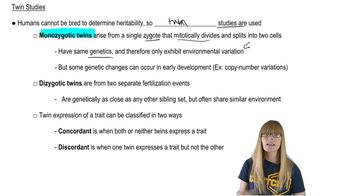A powerful approach to identifying genes of a developmental pathway is to screen for mutations that suppress or enhance the phenotype of interest. This approach was undertaken to elucidate the genetic pathway controlling C. elegans vulval development. In a complementary experiment, a gain-of-function let-23 mutant with a multi-vulva phenotype was also mutagenized. What types of mutations will suppress the multi-vulva phenotype?
Table of contents
- 1. Introduction to Genetics51m
- 2. Mendel's Laws of Inheritance3h 37m
- 3. Extensions to Mendelian Inheritance2h 41m
- 4. Genetic Mapping and Linkage2h 28m
- 5. Genetics of Bacteria and Viruses1h 21m
- 6. Chromosomal Variation1h 48m
- 7. DNA and Chromosome Structure56m
- 8. DNA Replication1h 10m
- 9. Mitosis and Meiosis1h 34m
- 10. Transcription1h 0m
- 11. Translation58m
- 12. Gene Regulation in Prokaryotes1h 19m
- 13. Gene Regulation in Eukaryotes44m
- 14. Genetic Control of Development44m
- 15. Genomes and Genomics1h 50m
- 16. Transposable Elements47m
- 17. Mutation, Repair, and Recombination1h 6m
- 18. Molecular Genetic Tools19m
- 19. Cancer Genetics29m
- 20. Quantitative Genetics1h 26m
- 21. Population Genetics50m
- 22. Evolutionary Genetics29m
14. Genetic Control of Development
Developmental Patterning Genes
Problem 21a
Textbook Question
The Hoxd9–13 genes are thought to specify digit identity. What would be the consequence of ectopically expressing Hoxd10 throughout the developing mouse limb bud? What about Hoxd11? What about both Hoxd10 and Hoxd11?
 Verified step by step guidance
Verified step by step guidance1
Understand the role of Hox genes: Hox genes are a group of related genes that control the body plan of an embryo along the head-tail axis. Specifically, Hoxd9–13 genes are involved in specifying digit identity in limb development. Ectopic expression refers to the abnormal expression of a gene in a location where it is not normally expressed.
Analyze the effect of ectopically expressing Hoxd10: Hoxd10 is normally expressed in the proximal regions of the limb bud. If Hoxd10 is ectopically expressed throughout the limb bud, it could lead to a shift in the identity of distal limb structures (such as digits) toward more proximal structures, potentially disrupting normal digit formation.
Consider the effect of ectopically expressing Hoxd11: Hoxd11 is typically expressed in the intermediate regions of the limb bud. Ectopic expression of Hoxd11 throughout the limb bud might result in intermediate limb structures being specified in regions where distal or proximal structures should form, altering the normal pattern of limb development.
Evaluate the combined effect of ectopically expressing both Hoxd10 and Hoxd11: Co-expression of Hoxd10 and Hoxd11 throughout the limb bud could lead to a more severe disruption of limb patterning. The combined effect might result in a loss of distal structures (digits) and an overrepresentation of proximal or intermediate structures, as the normal gradient of Hox gene expression would be disrupted.
Summarize the consequences: The ectopic expression of Hox genes disrupts the spatial and temporal regulation of limb development, which is critical for proper digit identity. The specific consequences depend on the gene(s) expressed and their normal roles in limb patterning. Experimental evidence or further modeling would be needed to confirm the exact phenotypic outcomes.
 Verified video answer for a similar problem:
Verified video answer for a similar problem:This video solution was recommended by our tutors as helpful for the problem above
Video duration:
3mPlay a video:
Was this helpful?
Key Concepts
Here are the essential concepts you must grasp in order to answer the question correctly.
Hox Genes
Hox genes are a group of related genes that determine the body plan and the identity of segments in an organism during embryonic development. They are crucial for the proper formation of limbs and other structures, as they provide positional information that dictates where specific body parts will develop. In vertebrates, different Hox genes are expressed in specific regions, influencing the morphology of limbs and digits.
Recommended video:
Guided course

Plant HOX genes
Ectopic Expression
Ectopic expression refers to the abnormal expression of a gene in a location where it is not normally expressed. In the context of developmental biology, ectopic expression of Hox genes can lead to the formation of structures in inappropriate locations, potentially resulting in malformations. For example, ectopically expressing Hoxd10 in the limb bud could disrupt normal digit formation, leading to altered digit identity or number.
Recommended video:
Guided course

Penetrance and Expressivity
Digit Identity
Digit identity refers to the specific characteristics and functions of individual digits (fingers and toes) in vertebrates, which are determined by the expression of specific Hox genes. Each digit is associated with a particular Hox gene expression pattern, which influences its development and identity. Alterations in the expression of these genes, such as through ectopic expression, can lead to changes in digit identity, resulting in phenotypic variations or abnormalities.
Recommended video:
Guided course

Twin Studies
Related Videos
Related Practice
Textbook Question
546
views


